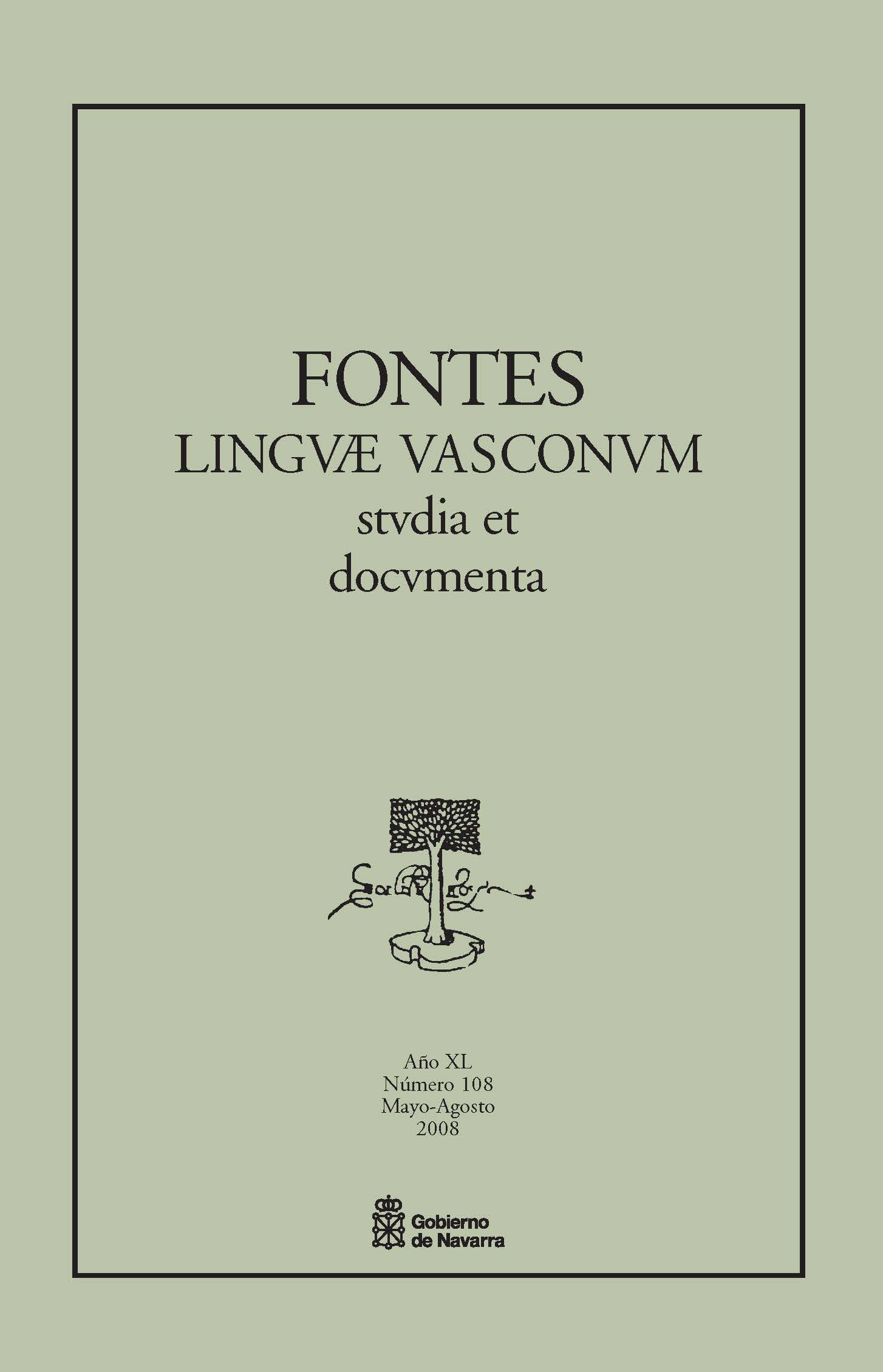Sobre el significado arcaico de las formas con prefijo l-: su uso en Lazarraga [On the erstwhile past-impferfective use of the l- prefixed irrealis forms of Basque]
Abstract
In this paper, I use the manuscript by the Alavese writer Joan Pérez de Lazarraga (Larrea, Alava, 16th century) in order to test the following hypothesis on the semantic value of the Basque verbal prefix l-: Originally, the Basque verbal forms with an l- prefix used to express a past imperfective. Later on, they developed secondary modal meanings in the sphere of irrealis. By the 16th century, these forms had almost entirely lost their original imperfective meaning, ousted by other forms, and were thus confined to their modal function. How - ever, we can already find in 16th century texts some l-prefixed forms which convey past imperfective meaning in conservative contexts; that is, in subordinate clauses. The goal of this article is to examine what specific values the l-prefixed forms express in Lazarraga’s manuscript, and in what contexts. This way, we will be able to test the plausibility of the hypothesis presented above. As we will see, the conclusion from this testing is that, although of course the hypothesis can never be demonstrated, Lazarraga’s use of the l-prefixed forms make it a very plausible one.
##about.statistics##
References
ALDAI, Gontzal, 2000, "Split ergativity in Basque: The pre-Basque antipassive-imperfective hypothesis", Folia Linguistica Historica, 21, 31-97. https://doi.org/10.1515/flih.2000.21.1-2.31
ALDAI, Gontzal, en prensa. "Sobre la conjugación sintética, el prefijo *e-, y la clase de verbos achievement en proto-vasco", ASJU.
BYBEE, Joan, 2002, "Main clauses are innovative, subordinate clauses are conservative: consequences for the nature of constructions", in Joan BYBEE & Michael NOONAN (eds.), Complex
sentences in grammar and discourse. Essays in honor of Sandra A. Thompson, Amsterdam / Philadelphia, John Benjamins. https://doi.org/10.1075/z.110.02byb
BYBEE, Joan; Revere PERKINS & William PAGLIUCA, 1994, The evolution of grammar: Tense, aspect, and modality in the languages of the world, Chicago / London, University of Chicago Press.
COMRIE, Bernard, 1976, Aspect: an introduction to the study of verbal aspect and related problems, Cambridge, Cambridge University Press.
COMRIE, Bernard, 1986, "Tense in indirect speech", Folia Linguistica, 20, 265-296. https://doi.org/10.1515/flin.1986.20.3-4.265
DAHL, Östen, 1997, "The relation between past time reference and counter-factuality: a new look", in Angeliki ATHANASIADOU & René DIRVEN (eds.), On conditionals again, Amsterdam /
Philadelphia, John Benjamins, 97-114. https://doi.org/10.1075/cilt.143.06dah
FLEISCHMAN, Suzanne, 1995, "Imperfective and irrealis", in Joan BYBEE & Suzanne FLEISCH MAN (eds.), Modality in grammar and discourse, Amsterdam / Philadelphia, John Benjamins, 519-551. https://doi.org/10.1075/tsl.32.23fle
JAMES, Deborah, 1982, "Past tense and the hypothetical: a cross-linguistic study", Studies in Language, 6, 375-403. https://doi.org/10.1075/sl.6.3.04jam
KINTANA, Xabier, 2004, "Joan Perez Lazarragakoren izkribuaren inguruan", Fontes Linguae Vasconum, 36, 581-595.
KROCH, Anthony, 1989, "Reflexes of grammar in patterns of language change", Language Variation and Change, 1, 199-244. https://doi.org/10.1017/S0954394500000168
LAFON, René, 1943, Le système du verbe Basque au XVI siècle, 2 volúmenes. Reimpreso en 1980 (en un volumen) en San Sebastián, Elkar.
LAFON, René, 1956, "Les formes verbales de prétérit à préfixe l- dans les textes du XVIe siècle". Reimpreso en Vasconiana, Iker-11, 1999, Bilbao, Euskaltzaindia, 459-473.
LAKARRA, Joseba A, 2006, "Notas sobre iniciales, cambio tipológico y prehistoria del verbo vasco", in Joseba A. LAKARRA & José Ignacio HUALDE (eds.), Studies in Basque and historical linguistics in memory of R.L. Trask, San Sebastian, Diputación Foral de Gipuzkoa, 561-622.
LANGACKER, Ronald, 1978, "The form and meaning of the English auxiliary", Language, 54, 853-882. https://doi.org/10.2307/413237
LIGHTFOOT, David, 1991, How to set parameters: arguments from language change, Cambridge, Massachusetts, MIT Press.
MICHELENA, Luis, 1988, Sobre Historia de la Lengua Vasca, 2 volúmenes, San Sebastián, Diputación Foral de Guipúzcoa.
MICHELENA, Luis & María Milagros BIDEGAIN, 1954. "Las escrituras apócrifas de Andramendi". Reimpreso en MICHELENA, 1988, 838-850.
STEELE, Susan, 1975, "Past and irrealis: just what does it all mean?", International Journal of American Linguistics (IJAL), 41, 200-217. https://doi.org/10.1086/465362
TRASK, Robert L, 1977, "Historical syntax and Basque verbal morphology: two hypotheses", in William DOUGLASS, Richard ETULAIN & William JACOBSEN (eds.), Anglo-American contributions to
Basque studies: Essays in honor of Jon Bilbao, Reno, Desert Research Institute Publications on the Social Sciences, 203-217
Copyright (c) 2008 Gontzal Aldai

This work is licensed under a Creative Commons Attribution-NonCommercial 4.0 International License.







